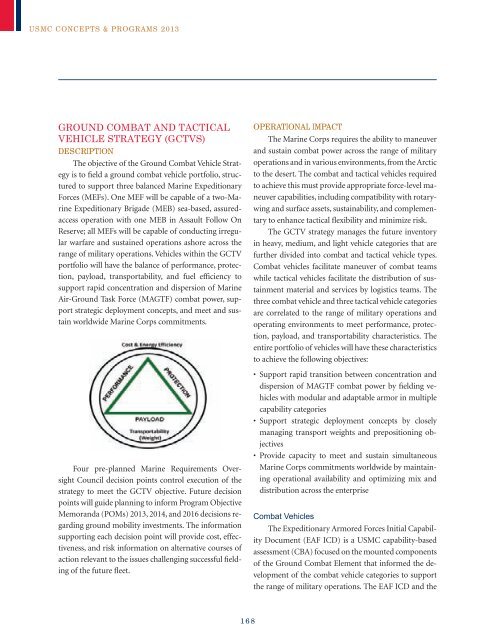USMC Concepts & Programs 2013 - Defense Innovation Marketplace
USMC Concepts & Programs 2013 - Defense Innovation Marketplace
USMC Concepts & Programs 2013 - Defense Innovation Marketplace
Create successful ePaper yourself
Turn your PDF publications into a flip-book with our unique Google optimized e-Paper software.
<strong>USMC</strong> <strong>Concepts</strong> & <strong>Programs</strong> <strong>2013</strong><br />
GROUND COMBAT and TACTICAL<br />
VEHICLE STRATEGY (GCTVS)<br />
Description<br />
The objective of the Ground Combat Vehicle Strategy<br />
is to field a ground combat vehicle portfolio, structured<br />
to support three balanced Marine Expeditionary<br />
Forces (MEFs). One MEF will be capable of a two-Marine<br />
Expeditionary Brigade (MEB) sea-based, assuredaccess<br />
operation with one MEB in Assault Follow On<br />
Reserve; all MEFs will be capable of conducting irregular<br />
warfare and sustained operations ashore across the<br />
range of military operations. Vehicles within the GCTV<br />
portfolio will have the balance of performance, protection,<br />
payload, transportability, and fuel efficiency to<br />
support rapid concentration and dispersion of Marine<br />
Air-Ground Task Force (MAGTF) combat power, support<br />
strategic deployment concepts, and meet and sustain<br />
worldwide Marine Corps commitments.<br />
Four pre-planned Marine Requirements Oversight<br />
Council decision points control execution of the<br />
strategy to meet the GCTV objective. Future decision<br />
points will guide planning to inform Program Objective<br />
Memoranda (POMs) <strong>2013</strong>, 2014, and 2016 decisions regarding<br />
ground mobility investments. The information<br />
supporting each decision point will provide cost, effectiveness,<br />
and risk information on alternative courses of<br />
action relevant to the issues challenging successful fielding<br />
of the future fleet.<br />
Operational Impact<br />
The Marine Corps requires the ability to maneuver<br />
and sustain combat power across the range of military<br />
operations and in various environments, from the Arctic<br />
to the desert. The combat and tactical vehicles required<br />
to achieve this must provide appropriate force-level maneuver<br />
capabilities, including compatibility with rotarywing<br />
and surface assets, sustainability, and complementary<br />
to enhance tactical flexibility and minimize risk.<br />
The GCTV strategy manages the future inventory<br />
in heavy, medium, and light vehicle categories that are<br />
further divided into combat and tactical vehicle types.<br />
Combat vehicles facilitate maneuver of combat teams<br />
while tactical vehicles facilitate the distribution of sustainment<br />
material and services by logistics teams. The<br />
three combat vehicle and three tactical vehicle categories<br />
are correlated to the range of military operations and<br />
operating environments to meet performance, protection,<br />
payload, and transportability characteristics. The<br />
entire portfolio of vehicles will have these characteristics<br />
to achieve the following objectives:<br />
• Support rapid transition between concentration and<br />
dispersion of MAGTF combat power by fielding vehicles<br />
with modular and adaptable armor in multiple<br />
capability categories<br />
• Support strategic deployment concepts by closely<br />
managing transport weights and prepositioning objectives<br />
• Provide capacity to meet and sustain simultaneous<br />
Marine Corps commitments worldwide by maintaining<br />
operational availability and optimizing mix and<br />
distribution across the enterprise<br />
Combat Vehicles<br />
The Expeditionary Armored Forces Initial Capability<br />
Document (EAF ICD) is a <strong>USMC</strong> capability-based<br />
assessment (CBA) focused on the mounted components<br />
of the Ground Combat Element that informed the development<br />
of the combat vehicle categories to support<br />
the range of military operations. The EAF ICD and the<br />
168

















